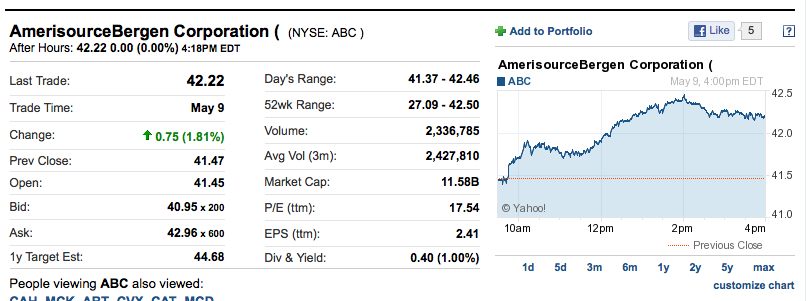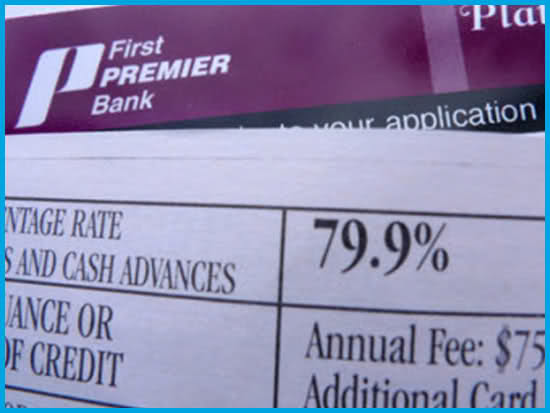Q: Dear Control Your Cash, how do I read a stock quote?
A: Considering that you’re just a literary construct and not an actual person, it doesn’t really matter.
Q: Thanks. You know how to make a girl feel special.
Tickers and charts are easy to understand if you know what you’re doing. Take stock ABC, for instance.
That’s not an idiom. Take stock ABC. That’s the ticker symbol for AmerisourceBergen, a drug wholesaler based out of suburban Philadelphia. ABC trades on the New York Stock Exchange, which is what the “NYSE” represents on this page.
The first line tells you what price a share of ABC last traded at (as of 1:49 p.m. ET today), and how much ABC gained or lost from the previous trading day (last Friday).
That covers everything down to the Previous Close line in the first column. Open means what price ABC first traded at today. That gives you an idea of what direction ABC’s price was heading in earlier, but it’s not as important at what ABC closed at.
Bid and Ask are a little more complicated. For large, heavily traded companies, Bid and Ask usually don’t apply. But for companies whose stock trades sporadically, they’re important. That’ll require us to look at a different company for a while; DEF.
DEF is Claymore/Sabrient Defensive Equity exchange-traded fund (more on these later), which is operated by Claymore, a Chicago financial firm. DEF trades on NYSEArca, a smaller, online-only exchange that features the stocks of small companies.
You’ll notice it’s been a few hours since someone bought DEF. For a decently sized company, that’d be all but impossible. Shares of DEF last traded at 20.77 (these numbers will obviously have changed by the time you read this.) But since then, no one’s been willing to buy it for that much, nor has anyone who owns it been willing to sell it for that little. Buyers are offering 20.77 for more shares, but there are none left at that price. Because no one’s willing to sell it for less than 20.79. The broker who bid 20.77 a share for DEF was willing to buy a lot consisting of 3500 shares at that price. The broker who was asking 20.79 a share for DEF was offering a lot of 2500 shares.
Alright, back to ABC. The 1-year target estimate is what some analyst thinks the price will be a year from now. Treat this with the skepticism it deserves.
Day’s range and 52-week range are self-explanatory. Volume is the number of shares that were traded today. But you can’t multiply Volume by Last Trade to get the dollar value of the number of shares traded today, because not all the shares traded at 24.60. (Of course not, they fluctuated between the numbers listed in Day’s Range.)
The (3m) after Average Volume means 3 months.
Market Capitalization is essentially what the company is worth. There are several ways to value a company, the most obvious one being what someone would be willing to pay for it. But since there’s probably no one who wants to buy every last share of ABC, the best we can do is multiply the price of a share by the number of outstanding shares. Makes sense, right? The chart tells us that ABC is thus worth $7.2 billion.
Which means we now have an idea of how many outstanding shares of ABC there are, which would be 293 million (give or take a tenth of a percent or so, thanks to rounding.) Not that that’s important in and of itself, but it does tell us that about .42% of ABC’s outstanding shares have changed hands today. Which means that 99.58% of ABC’s outstanding shares stayed right where they were. (When the hotties on Fox Business say that “trading was heavy today”, it’s relative. Trading is always pretty light.)
The next two items should be reversed. Let’s start with EPS, which is earnings per share. It’s how much money the company made (according to its annual income statement), divided by the number of outstanding shares. A little multiplication shows that ABC made about $486 million last year, which is excellent, especially considering ABC’s market capitalization. (ttm) means trailing 12 months; in other words, looking at the company’s earnings over the past year.
P/E is price/earnings ratio, which is a indirect measure of what investors think a company’s stock will be worth. It’s the stock price divided by EPS.
ABC investors are willing to pay $14.79 for every dollar of income the company generates annually. In other words, it would take about 14.79 years for the stock to earn enough to pay for itself.
Which isn’t bad. Say you have another investment, like a $100,000 house that you rent out. If it took you 14.79 years to collect enough rent to pay for the house, that’d be an annual rate of return of 6.76%.
P/E ratio is important enough that it warrants its own post, but for now just know that a high number (usually >17 or so) means that the stock is either overvalued, or investors think it’s going to earn a lot more in the future. A number from 0-10 means that the company stock is a bargain, or the company’s going to start earning less. (A negative number means the company’s losing money.) ABC’s P/E ratio just happens to be right around what’s normally considered fair value. P/E ratios depend hugely on what industry a company is in. For instance, a healthy electric utility will usually have a lower P/E than will a barely profitable tech company. Governments regulate utilities heavily, and while they’re profitable, they cost a ton to start up and their profits are usually limited if steady.
That leaves Dividend and Yield. Successful, consistently profitable companies pay shareholders a dividend – sometimes annually, sometimes quarterly, sometimes even monthly. It’s a piece of the profits earmarked just for this purpose. If that sounds unduly generous, keep in mind that the shareholders own the company: it’s their money. They authorize the board of directors to hire executives who’ll authorize dividends, and those directors and executives hold shares themselves.
To keep things uniform, dividends are expressed annually. So if a company happens to pay a quarterly dividend, the number listed here is 4 times that. Yield is the dividend divided by the share price.
Q: Wow, Control Your Cash. You’re really smart. Did I mention that I’m tall, blonde, statuesque and lonely?
A: Very funny.





